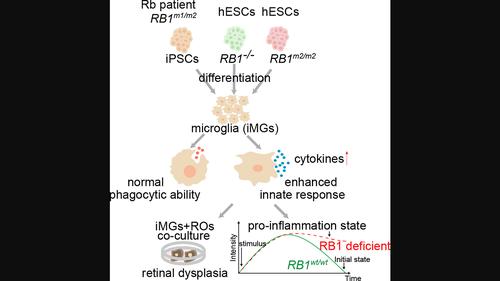Our official English website, www.x-mol.net, welcomes your feedback! (Note: you will need to create a separate account there.)
Enhanced innate responses in microglia derived from retinoblastoma patient-specific iPSCs
Glia ( IF 6.2 ) Pub Date : 2024-01-22 , DOI: 10.1002/glia.24507 Jia Xu 1 , Si‐Jian Yu 1 , Shuning Sun 1 , Yan‐Ping Li 1 , Xiao Zhang 1 , Kangxin Jin 1 , Zi‐Bing Jin 1
Glia ( IF 6.2 ) Pub Date : 2024-01-22 , DOI: 10.1002/glia.24507 Jia Xu 1 , Si‐Jian Yu 1 , Shuning Sun 1 , Yan‐Ping Li 1 , Xiao Zhang 1 , Kangxin Jin 1 , Zi‐Bing Jin 1
Affiliation

|
RB1 deficiency leads to retinoblastoma (Rb), the most prevalent intraocular malignancy. Tumor-associated macrophages (TAMs) are related to local inflammation disorder, particularly by increasing cytokines and immune escape. Microglia, the unique resident macrophages for retinal homeostasis, are the most important immune cells of Rb. However, whether RB1 deficiency affects microglial function remain unknown. In this study, microglia were successfully differentiated from Rb patient- derived human induced pluripotent stem cells (hiPSCs) and human embryonic stem cells (hESCs), and then we investigated the function of RB1 in microglia by live imaging phagocytosis assay, immunofluorescence, RNA-seq, qRT-PCR, ELISA and retina organoids/microglia co-culturing. RB1 was abundantly expressed in microglia and predominantly located in the nucleus. We then examined the phagocytosis ability and secretion function of iMGs in vitro. We found that RB1 deficiency did not affect the expression of microglia-specific markers or the phagocytic abilities of these cells by live-imaging. Upon LPS stimulation, RB1-deficient microglia displayed enhanced innate immune responses, as evidenced by activated MAPK signaling pathway and elevated expression of IL-6 and TNF-α at both mRNA and protein levels, compared to wildtype microglia. Furthermore, retinal structure disruption was observed when retinal organoids were co-cultured with RB1-deficient microglia, highlighting the potential contribution of microglia to Rb development and potential therapeutic strategies for retinoblastoma.
中文翻译:

视网膜母细胞瘤患者特异性 iPSC 衍生的小胶质细胞的先天反应增强
RB1 缺乏会导致视网膜母细胞瘤 (Rb),这是最常见的眼内恶性肿瘤。肿瘤相关巨噬细胞(TAM)与局部炎症紊乱有关,特别是通过增加细胞因子和免疫逃逸。小胶质细胞是维持视网膜稳态的独特常驻巨噬细胞,是 Rb 最重要的免疫细胞。然而,RB1 缺乏是否影响小胶质细胞功能仍不清楚。在本研究中,小胶质细胞成功地从Rb患者来源的人诱导多能干细胞(hiPSC)和人胚胎干细胞(hESC)中分化出来,然后我们通过活体成像吞噬实验、免疫荧光、RNA- seq、qRT-PCR、ELISA 和视网膜类器官/小胶质细胞共培养。RB1 在小胶质细胞中大量表达,并且主要位于细胞核中。然后我们在体外检查了 iMG 的吞噬能力和分泌功能。我们通过实时成像发现 RB1 缺陷不会影响小胶质细胞特异性标记物的表达或这些细胞的吞噬能力。在 LPS 刺激后,与野生型小胶质细胞相比,RB1 缺陷型小胶质细胞表现出增强的先天免疫反应,这一点可以通过激活 MAPK 信号通路以及在 mRNA 和蛋白质水平上升高的 IL-6 和 TNF-α 表达来证明。此外,当视网膜类器官与缺乏 RB1 的小胶质细胞共培养时,观察到视网膜结构破坏,这凸显了小胶质细胞对 Rb 发育的潜在贡献以及视网膜母细胞瘤的潜在治疗策略。
更新日期:2024-01-22
中文翻译:

视网膜母细胞瘤患者特异性 iPSC 衍生的小胶质细胞的先天反应增强
RB1 缺乏会导致视网膜母细胞瘤 (Rb),这是最常见的眼内恶性肿瘤。肿瘤相关巨噬细胞(TAM)与局部炎症紊乱有关,特别是通过增加细胞因子和免疫逃逸。小胶质细胞是维持视网膜稳态的独特常驻巨噬细胞,是 Rb 最重要的免疫细胞。然而,RB1 缺乏是否影响小胶质细胞功能仍不清楚。在本研究中,小胶质细胞成功地从Rb患者来源的人诱导多能干细胞(hiPSC)和人胚胎干细胞(hESC)中分化出来,然后我们通过活体成像吞噬实验、免疫荧光、RNA- seq、qRT-PCR、ELISA 和视网膜类器官/小胶质细胞共培养。RB1 在小胶质细胞中大量表达,并且主要位于细胞核中。然后我们在体外检查了 iMG 的吞噬能力和分泌功能。我们通过实时成像发现 RB1 缺陷不会影响小胶质细胞特异性标记物的表达或这些细胞的吞噬能力。在 LPS 刺激后,与野生型小胶质细胞相比,RB1 缺陷型小胶质细胞表现出增强的先天免疫反应,这一点可以通过激活 MAPK 信号通路以及在 mRNA 和蛋白质水平上升高的 IL-6 和 TNF-α 表达来证明。此外,当视网膜类器官与缺乏 RB1 的小胶质细胞共培养时,观察到视网膜结构破坏,这凸显了小胶质细胞对 Rb 发育的潜在贡献以及视网膜母细胞瘤的潜在治疗策略。



























 京公网安备 11010802027423号
京公网安备 11010802027423号